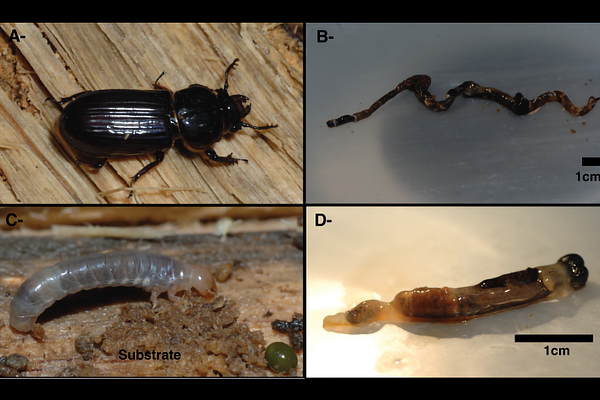The gut microbiome of the Passalid beetle has high cellulolytic potential and constitutes an unrecognized system for production of greenhouse gasses in neotropical forests

The gut microbiome of the Passalid beetle has high cellulolytic potential and constitutes an unrecognized system for production of greenhouse gasses in neotropical forests
Vargas, G.; Pinto-Tomas, A. A.; Murillo-Cruz, C.; Hernandez, M.; Dierick, D.; Hernandez, C.; Soto, S.; Chaves, I. Z.; Glavina del Rio, T.; Tringe, S. G.; Clardy, J.; Sherman, D. H.; Tamayo-Castillo, G.
AbstractHerbivores, and their associated microbiomes, play a major role in the global carbon cycle. Recalcitrant cellulose molecules are broken down by microorganisms that colonize the herbivore gut, releasing greenhouse gasses in the process. Passalid beetles are tropical herbivores that feed only on decaying wood and present subsocial behavior that may lead to the acquisition and sharing of microbial symbionts for efficient biomass and energy production. We collected five groups of Veturius sp. Passalid beetles from different logs in the Costa Rican rainforest and analyzed the microbial communities of larval and adult guts, as well as the substrate material in which they resided (partially chewed wood material mixed with feces that covers their tunnels). Adults, larvae, and substrate harbor different microbial communities, with substrate showing the highest diversity and richness, and larvae gut comprising a high abundance of methanogenic archaea. Reconstructed metagenome assembled genomes (MAGs) revealed that larvae and adults are enriched in genomes encoding a myriad of glycosyl hydrolases. Methanogenic taxa were enriched within the larval MAGs and bins, suggesting that larval microbiota participate in the final steps of cellulose decomposition in the system. Finally, we assessed methane production rates by Passalid beetles and compared them with termites. Our results show that Passalid larvae and adults produce methane at rates comparable to termites. Passalid and other beetle larvae are potentially underappreciated contributors to the carbon cycle and the biotic production of the greenhouse gas methane.